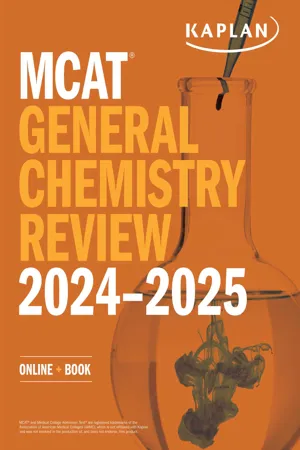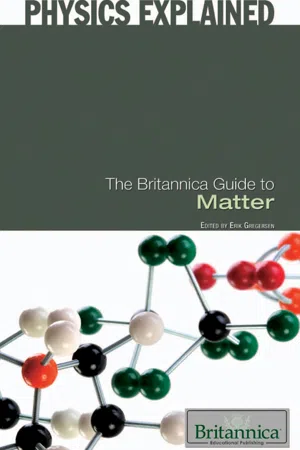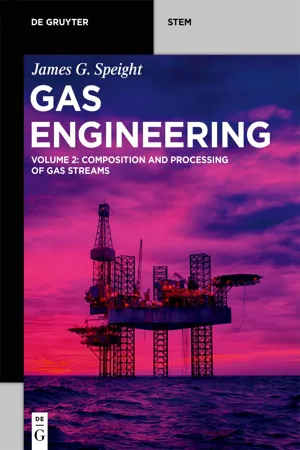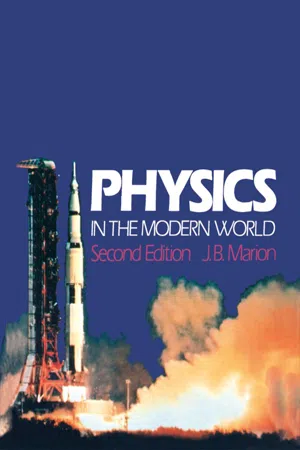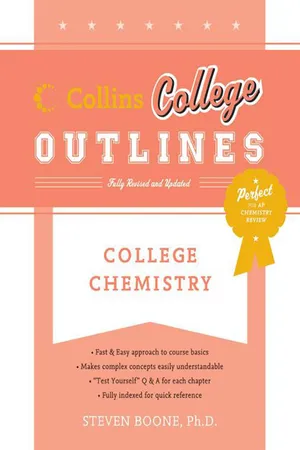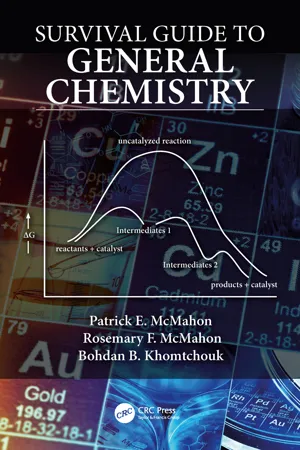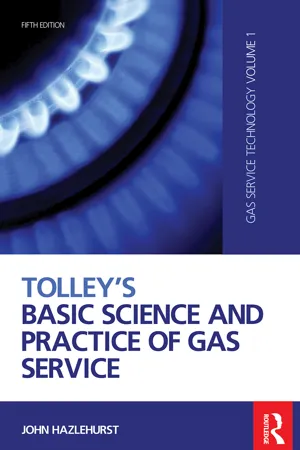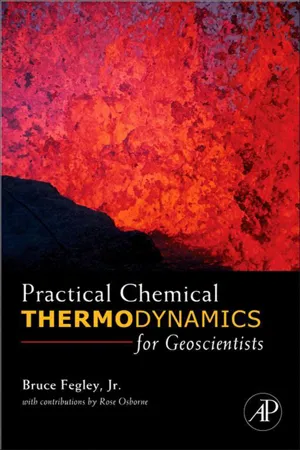Physics
Volume of Gas
The volume of gas refers to the amount of space occupied by a gas. It is typically measured in cubic meters or liters. The volume of a gas can change with variations in temperature, pressure, and the amount of gas present, as described by the ideal gas law.
Written by Perlego with AI-assistance
Related key terms
11 Key excerpts on "Volume of Gas"
- eBook - ePub
MCAT General Chemistry Review 2024-2025
Online + Book
- (Author)
- 2023(Publication Date)
- Kaplan Test Prep(Publisher)
as the number of moles of gas increases, the volume increases in direct proportion.Example:A 2.0 L sample at 100°C and 20 atm contains 5 moles of a gas. If an additional 25 moles of gas at the same pressure and temperature are added, what is the final volume of the gas?Solution:If pressure and temperature are held constant, the ideal gas law reduces to Avogadro’s principle:n 1V 1=n 2V 25 mol2.0 L=5 mol + 25 molV 2V 2== 12.0 L30 mol × 2 .0 L5 molBoyle’s Law
Robert Boyle conducted a series of experimental studies in 1660 that led to his formulation of a law that now bears his name: Boyle’s law. His work showed that, for a given gaseous sample held at constant temperature (isothermal conditions), the volume of the gas is inversely proportional to its pressure:PV = k or P1 V1 = P2 V2Equation 8.5where k is a constant, and the subscripts 1 and 2 represent two different sets of pressure and volume conditions. Careful examination of Boyle’s law shows that it is, indeed, simply the special case of the ideal gas law in which n and T are constant.KEY CONCEPT
Boyle’s law is a derivation of the ideal gas law and states that pressure and volume are inversely related: when one increases, the other decreases.A plot of volume vs. pressure for a gas—the inverse of the curves in Figure 8.2—is shown in Figure 8.3.Figure 8.3. Boyle’s Law (Isothermal Compression) As pressure increases, volume decreases.MCAT EXPERTISE
Sometimes it is easier to remember the shape of the graph to help you recall the variables’ relationship on Test Day. Here we can see that, as pressure increases, the volume decreases, and vice-versa. These ratios and relationships will often allow you to answer questions on the MCAT without having to do much math. - eBook - ePub
- Britannica Educational Publishing, Erik Gregersen(Authors)
- 2010(Publication Date)
- Britannica Educational Publishing(Publisher)
T is the absolute thermodynamic temperature. To a rough degree, the expression is accurate within a few percent if the volume is more than 10 times the critical volume; the accuracy improves as the volume increases. The expression eventually fails at both high and low temperatures, owing to ionization at high temperatures and to condensation to a liquid or solid at low temperatures.The ideal gas equation of state is an amalgamation of three ideal gas laws that were formulated independently. The first is Boyle’s law, which refers to the elastic properties of the gas; it was described by the Anglo-Irish scientist Robert Boyle in 1662 in his famous “… Experiments … Touching the Spring of the Air.…” It states that the volume of a gas at constant temperature is inversely proportional to the pressure; i.e., if the pressure on a gas is doubled, for example, its volume decreases by one-half. The second, usually called Charles’s law, is concerned with the thermal expansion of the gas. It is named in honour of the French experimental physicist Jacques-Alexandre-César Charles for the work he carried out in about 1787. The law states that the volume of a gas at constant pressure is directly proportional to the absolute temperature; i.e., an increase of temperature of 1 °C (1.8 °F) at room temperature causes the volume to increase by about 1 part in 300, or 0.3 percent.The third law embodied in equation (15) is based on the 1811 hypothesis of the Italian scientist Amedeo Avogadro—namely, that equal volumes of gases at the same temperature and pressure contain equal numbers of particles. The number of particles (or molecules) is proportional to the number of moles n , the constant of proportionality being Avogadro’s number, N 0 . Thus, at constant temperature and pressure the volume of a gas is proportional to the number of moles. If the total volume V contains n moles of gas, then only v = V/n appears in the equation of state. By measuring the quantity of gas in moles rather than grams, the constant R is made universal; if mass were measured in grams (and hence v in volume per gram), then R - eBook - ePub
Gas Engineering
Vol. 2: Composition and Processing of Gas Streams
- James G. Speight(Author)
- 2022(Publication Date)
- De Gruyter(Publisher)
The gas laws are derived from the following assumptions and which relate to the kinetic–molecular theory is based on the following assumptions: (1) a gas consists of tiny particles, either atoms or molecules, moving about at random, (2) the volume of the particles themselves is negligible compared with the total volume of the gas, (3) the gas particles act independently of one another; there are no attractive or repulsive forces between particles, (4) collisions of the gas particles, either with other particles or with the walls of a container, are elastic so that the total kinetic energy of the gas particles is constant at constant temperature, and (5) the average kinetic energy of the gas particles is proportional to the Kelvin temperature (in Kelvin, K) of the sample. Beginning with these assumptions, it is possible not only to understand the behavior of gases but also to derive quantitatively a series of laws leading to the derivation of the ideal gas law.Thus, by definition, gases are the state of matter in which the molecules are far apart from each other and are characterized by a lack of definite volume and density. The following laws (listed alphabetical rather than by any preference) are (1) Avogadro’s law, (2) Boyle’s law, (3) Charles law, (4) Gay-Lussac’s law, (5) Graham’s law, and (6) the ideal gas law; these laws provide the relation between mass, pressure, volume, temperature, and density of ideal gas molecules.Gases, unlike solids and liquids, show similar physical behavior regardless of the chemical makeup of the gas. Form this behavior, the properties of any gas can be defined by four variables, namely (1) the pressure, P, (2) the temperature, T, (3) the volume, V, and (4) the number of moles, n, and the specific relationships among these four variables form the basis for the gas laws and, consequently, an ideal gas is a gas whose behavior follows the gas laws.There are two types of gases: an ideal gas and a nonideal gas. An ideal gas has the following properties: (1) there are no intermolecular forces between the gas particles, (2) the volume occupied by the particles is negligible compared to the volume of the container they occupy, and (3) the only interactions between the particles and with the container walls are perfectly elastic collisions.An ideal gas can be characterized by three variables which are (1) the absolute pressure, P, (2) the volume, V, and (3) the absolute temperature, T. Thus:P V = n Z R TTypically, in this equation, P is the pressure, V is the volume, T is the absolute temperature in Kelvin, Z is the compressibility, n is the number of kilomoles, and R - eBook - ePub
- Eiichi Kondoh(Author)
- 2022(Publication Date)
- Jenny Stanford Publishing(Publisher)
2 between which attractive (or repulsive) interactions are negligible. We can ignore interactive forces when
Strictly speaking, no real gas satisfies these conditions and thus there is no ideal gas. However, feel safe, in most cases of vacuum, a gas can be treated as an ideal gas.{Molecular interactions are very weak, such as in rare gases .The gas is sufficiently rarefied .(2.2) The following equation tells the number of molecules in a volume at any given temperature and pressure. For instance, the number of molecules confined in 1 m3 under the standard state condition can be obtained by using the fact that 1 mol = NA ,N VN A=p=R T× 6.02 ×1.013 ×10 58.3145 × 27310 23= 2.69 ×10 25(2.3) That is, 1 ml contains 2.69 × 1019 molecules of gases. This shows that numerous molecules exist in a very small volume.The number of molecules contained in a unit volume is known as number density. When pressure is reduced under constant temperature, the number density decreases, and when number density is kept constant, the temperature decreases. Rewriting Eq. (2.1) asp = n K T(2.4) where n = NNA / V. The unit of number density is m−3 .The ideal gas law states that pressure, temperature, and density are identical quantities. Hereafter, we will call the above equation “ideal gas law at molecular level,” in this book because this equation is a rewrite of Eq. (2.1) with respect to gas molecules. This equation shows a direct connection between pressure and temperature.2.3 Gas Pressure and Internal Energy
Even a miniscule volume contains numerous gas molecules that travel at a breakneck speed. Their motion is translatory, and therefore, its direction changes very frequently on collision with the vacuum chamber wall or other molecules (Fig. 2.1 ). As a result, it becomes a perfectly random motion. Therefore the motion is analyzed statistically.Figure 2.1 Motion of gas molecules filled in a volume.2.3.1 Gas Pressure and Speed of Gas Molecules
Gas molecules move freely and randomly in a container. Pressure is the force that the molecules exert on colliding with the wall of the container. - eBook - ePub
- Jerry Marion(Author)
- 2012(Publication Date)
- Academic Press(Publisher)
T held constant, Boyle found that the product of pressure and volume always remains constant. That is,FIGURE 10-9 Robert Boyle discovered the relationship that connects the volume and the pressure of a confined gas at constant temperature: PV = constant.P V = constant(10-8)(when T is contant)(10-8)This relationship is called Boyle’s law .For a series of three different conditions such as those shown in Fig. 10-9 , we have(10-8a)P 1V 1=P 2V 2=P 3V 3(when T is constant)(10-8a)In order to halve the volume of a gas, the pressure must be doubled , and so forth.For a particular sample of gas, the “constant” in PV = constant is the same for all pressure−volume combinations. But for a different quantity of gas, the “constant” will have a different value.The Law of Charles and Gay-Lussac
An extension of Boyle’s law was made in 1802 by the French physicists Jacques Charles (1746-1823) and Joseph Louis Gay-Lussac (1778-1850), who, independently of one another, discovered the way in which the volume of a gas varies with temperature for constant pressure.In order to see the way in which the volume and temperature of a gas are related, let us examine a specific case. Suppose that we confine a certain quantity of gas in a cylinder. We adjust the conditions until the temperature is 0 °C and the volume of the gas 273 cm3 (see Fig. 10-10 ). For all of the remaining operations, we maintain the same pressure . If we lower the temperature to − 1 °C, we find that the volume of the gas decreases to 272 cm3 . At a temperature of −2 °C, the volume is 271 cm3 . That is, for each degree that the temperature is lowered, the volume decreases by 1 cm3 or of the original volume. When T = 173 °C is reached, we find V = 100 cm3 . If the gas continues to behave in this way, we would expect that a temperature of − 273 °C would result in zero volume. We cannot actually reach this extreme condition because (a) any real gas would liquefy at a temperature above − 273 °C and (b) the temperature − 273 °C can never be attained in any real system. In spite of these practical difficulties, the temperature T = − 273 °C has an important significance because it represents the lowest temperature that is conceivable (even if it cannot actually be attained - Available until 11 Jul |Learn more
- Steven Boone, Drew H. Wolfe(Authors)
- 2011(Publication Date)
- Collins Reference(Publisher)
CHAPTER 6Gases
T his chapter considers the properties of substances in the gas phase. (In Chapter 12, we will complete our discussion of physical states by studying the more condensed states of matter, liquids, and solids.) In addition, we will also consider the theory that is used to explain the properties of gases—the kinetic-molecular theory.6.1 INTRODUCTION TO THE GAS PHASEThe gas phase is the least dense state of matter, which means the small particles that compose it (atoms and molecules) are widely separated and exert weak attractive forces on each other. Properties of Gases Gases totally fill their containers, and their volumes depend on the pressure exerted on them. They are the most fluid of the three physical states. Ideal Gases versus Real GasesAn ideal gas is a term used to describe the behavior of hypothetical gases, given a set of simplifying assumptions. Ideal gas molecules are infinitely small and interact only with perfect elastic collisions. One property of ideal gases is that they remain in the gas phase and never change state, regardless of the conditions. A real gas, of course, will condense into a liquid if it is sufficiently cooled, but the previous assumption and others enabled scientists to develop a mathematical model that is used to describe properties of gases under many conditions. To a degree, most real gases behave in a manner similar to ideal gases, but not exactly. Real gases most closely resemble ideal gases at higher temperatures and lower pressures.6.2 GAS PRESSUREGases must be characterized by a set of experimental conditions. Pressure is the first of the three conditions that are explored. Pressure Defined Pressure, P - eBook - ePub
- Patrick E. McMahon, Rosemary McMahon, Bohdan Khomtchouk(Authors)
- 2019(Publication Date)
- CRC Press(Publisher)
20 Working with Gas LawsI KINETIC THEORY OF GASES Phases of a compound or element (solid, liquid, gas) are determined by the balance between the strength of intermolecular forces and the average kinetic energy of the molecules. The gas phase is characterized by very weak attractive forces during which the average kinetic energy of motion dominates the physical properties of gases. For a restricted set of conditions, analysis of a gas is characterized by assuming that attractive forces between individual gas molecules are zero and that the volume occupied by the physical size of the molecules is essentially zero as compared to the volume of empty space between the molecules. Under these conditions, the gas, termed an ideal gas, is analyzed through the average statistical behavior of rapidly moving independent particles.Gases have very low density as there is a relatively large amount of empty space between individual molecules. Gases can have variable volumes; they can expand (molecules become farther apart) or be compressed (molecules are squeezed closer together). The pressure of a gas is produced by the kinetic energy of molecular collisions on the walls of the container. Gases can diffuse into each other; the rapidly moving molecules of two distinct gases can occupy the empty spaces between each other and form a gas solution (mixing at the molecular level).The kinetic energy of a gas molecule (or atom) in units of Joules is found from kE = ½ mv2 where m = the molecular (or atomic) mass in kilograms and v = velocity of the molecule in meters per second. The average kinetic energy of any sample of a specific molecular gas is determined by the molecular mass and the average or mean velocity: kE(average) = ½ m(v(average) )2 ; v(average) ≅ v(mean) - eBook - ePub
- Jeffrey Gaffney, Nancy Marley(Authors)
- 2017(Publication Date)
- Elsevier(Publisher)
law of combining volumes . For chemical reactions involving gases where the temperature and pressure do not change, volume relationships are the same as molar relationships. For cases where the temperature and pressure change during the reaction, the ideal gas law must be used to determine the amounts of products and reactants in moles.Example 6.10: Determining the Volume of Products in a Gas Phase Chemical Reaction How many liters of nitrogen monoxide are required to produce 3.0 L of nitrogen dioxide from the reaction with oxygen?1. Write the balanced chemical equation.2NO(g) + O2 (g) → NO2 (g)2. Determine the volume of product formed.According to the chemical equation, 2 L of NO will produce 1 L of NO2 .So, it will require 2 × 3.0 L = 6.0 L of NO to produce 3.0 L of NO2 .Important Terms
Absolute zero the lowest temperature that is theoretically possible, at which all molecular motion stops.Avogadro’s law equal volumes of gases at the same temperature and pressure contain the same number of molecules regardless of their chemical nature and physical properties.Barometer an instrument measuring atmospheric pressure.Boyle’s law the absolute pressure and the volume of a gas are inversely proportional at constant temperature and fixed mass.Charles’ law at constant pressure, the volume of a fixed mass of any gas is directly proportional to the absolute temperature in degrees Kelvin.Combined gas law the ratio between the pressure-volume product and the absolute temperature of a fixed mass of gas measured in Kelvin remains constant. - eBook - ePub
Making Physics Fun
Key Concepts, Classroom Activities, and Everyday Examples, Grades K?8
- Robert Prigo(Author)
- 2015(Publication Date)
- Skyhorse(Publisher)
If the volume of the can were increased, without changing the number of molecules and temperature, the pressure of the gas would decrease. This would happen because with the larger volume, the molecules must travel a greater distances within the can before they hit the walls. This means they will hit less often and that the pressure would be reduced. Furthermore, if the volume increased, then there would be fewer molecules hitting per unit area, since the surface area would increase with the volume increase. This would contribute to a decrease in pressure. If the volume of the can were decreased, the argument would be that the molecules have less distance to travel and would hit more often and the number hitting per unit area would be more —both factors contributing to a higher gas pressure. In summary, the pressure of a gas (symbol P) depends on only three factors associated with the gas: the number of molecules (symbol N) that make up the gas, the temperature (symbol T) of the gas, and the volume (symbol V) of the gas. We can say that P grows directly with N and T, and inversely with V. In algebraic form, we can express these relationships in a single mathematical expression (often called the Ideal Gas Law): P =kNT/V The parameter k is a mathematical constant. This quantitative relationship works quite well for gases that are not too dense or complex. The scientists most responsible for its development were Robert Boyle (1627–1691), Jacques Charles (1746–1823), and Amedeo Avogadro (1776–1856). Activities Suction Cup Fun: You will need to locate suction cups of various sizes. You should also purchase two large suction cups of the type used to pull out car door dents or to carry panes of glass (Atmospheric Pressure Cups, Arbor Scientific). You might also want to purchase a couple of plumber’s helpers (toilet plungers). Stick two suction cups together. By forcing the air out of the space between the cups, you reduced the number of molecules (N) - John Hazlehurst(Author)
- 2009(Publication Date)
- Routledge(Publisher)
| eightMeasurement of Gas
Chapter 8 is based on an original draft prepared by Mr A. AlexanderTHE GAS LAWS
The word ‘laws’ in this case refers to the ‘law of nature’ or the physical ‘laws’ and not to man-made civil or criminal legislation.You already know that the volume of a gas is affected by changes in pressure and changes in temperature and that it is necessary to use standard reference conditions (src) before one volume can be compared with another. So we must look in more detail at the physical laws which link volume, pressure and temperature before going on to deal with the actual measurement of volume.Boyle’s law
Robert Boyle carried out experiments to discover the relationship between volume and pressure. He used the apparatus shown in Fig. 8.1 .Figure 8.1 Boyle’s Law apparatus.This consists of a glass tube, bent in the form of a U and with the shorter limb closed at the top. Mercury is poured in until the level of liquid is the same in each limb. At this point the pressure of the air on the surface of the liquid must be the same in each limb and is, in fact, atmospheric pressure.As more mercury is added, the level rises in the shorter limb, so compressing the air. But the level in the longer limb rises by a much greater amount and the difference in levels indicates the pressures being applied. By taking readings of the values of P (pressure) and V (volume) their relationship can be determined.The graph in Fig. 8.2 shows typical results. When the absolute pressure, P , is plotted against the volume V , you can see that P multiplied by V- Bruce Fegley Jr.(Author)
- 2012(Publication Date)
- Academic Press(Publisher)
Gases exert pressure in a way that is similar to solid bodies in that the pressure can still be described as force per unit area. A collection of gas particles in a balloon is moving around in all directions. The force of a great many collisions of gas particles against the sides of the balloon is what keeps the balloon inflated. The pressure inside the balloon is equal to the average amount of force per area exerted against the sides of the balloon, which will depend on the average velocity of the particles, their mass, and on how many collisions occur. The average number of collisions in turn depends on the gas density or number of particles (N) per volume (V). The kinetic theory of gases shows us that (2-7) for an ideal gas, where m is the average mass of the particles, N is the number of particles present, v is their average velocity, and V is the volume of their container. We discuss the relationship between P and V of a gas when we describe Boyle’s law later in this chapter. Example 2-2. At 300 K, N 2 molecules have an average velocity of about 517 m s −1. What pressure would 0.04 moles of N 2 gas at 300 K exert inside a 1 liter cylinder? The atomic weight of N is 14.00674 g mol −1, so the molecular weight of N 2 is 28.01348 g mol −1. (2-7) E Pressure measurement One of the first devices used to measure pressure was the manometer, a U-shaped tube partially filled with a fluid such as water, oil, or mercury, as pictured in Figure 2-8. One end of the tube connects to the system under observation. The other end is either open to the air, in which case the pressure measured is relative to the ambient pressure, or is a sealed vacuum, in which case an absolute pressure measurement is achieved (as in a barometer). A change in the pressure of the system changes the height of the mercury in the tube. The changes in height are measured visually or more precisely using a small telescope on a calibrated stand (a cathetometer)
Learn about this page
Index pages curate the most relevant extracts from our library of academic textbooks. They’ve been created using an in-house natural language model (NLM), each adding context and meaning to key research topics.
